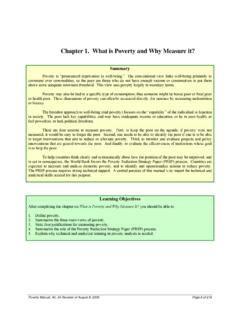Transcription of building a performance measurement system - …
1 building a performance measurement system USING DATA TO ACCELERATE SOCIAL IMPACT. by Andrew Wolk, Anand Dholakia, and Kelley Kreitz A Root Cause How-to Guide ABOUT THE AUTHORS. Andrew Wolk Widely recognized as a leading social innovator and a pioneering teacher of social entrepreneurship, Andrew founded Root Cause in 2004 and continues to lead its strategic direction. He consults to organizations across the nonprofit, for-profit, and government sec- tors that are seeking to advance effective solutions to pressing social problems. In addition, he has authored a number of publications on social innovation. They include a report for the Aspen Institute on policy recom- mendations for advancing social innovation, a chapter on social entrepreneurship and government in the Small Business Administration's 2007 annual report to the President of the United States, and Root Cause's first How-to Guide, Business Planning for Endur- ing Social Impact.
2 In 1999, Andrew designed and taught one of the first courses on social entrepreneurship in the country. For the past five years, he has taught social innovation and entrepreneurship at MIT. He is also a Gleitsman Visiting Practitioner in Social Innovation at the Center for Public Leadership at Harvard University's Kennedy School of Government. Anand Dholakia Anand is a senior consultant at Root Cause. Since joining Root Cause in 2005, he has led business planning engagements for non- profits and government agencies in a variety of fields, including aging, civic engagement, microfinance, transportation, and youth development. Anand has also worked extensively in the field of performance measurement and has developed performance mea- surement systems for numerous organizations in the United States and Bermuda.
3 Before joining Root Cause, he worked as an independent consultant to nonprofits and social enterprises in Greater Boston and in India, completing projects in strategy, busi- ness planning for earned income ventures, market research, and financial modeling. Kelley Kreitz Kelley developed and launched Root Cause's knowledge sharing initiative in 2006. As Root Cause's chief knowledge officer, she works with Root Cause consultants and clients to develop practical and field- building resources for advancing social innovation. She co-authored Root Cause's first How-to Guide, Business Planning for Enduring Social Impact, and has edited a number of publications on social innovation. Before joining Root Cause, Kelley worked for New Profit Inc.
4 On initiatives aimed at building the field of social entrepreneurship and served as the senior writer for , a knowledge center on business and the environment. building a performance measurement system USING DATA TO ACCELERATE SOCIAL IMPACT. Root Cause Cambridge, MA. Copyright 2009 Root Cause All rights reserved. No part of this publication may be reproduced, stored in a retrieval system , or transmitted in any form or by any means electronic, mechanical, photocopying, recording, or otherwise, without the prior written permission of the publisher. Published by Root Cause 675 Massachusetts Avenue, 9th Floor Cambridge, MA 02139. Design and Layout Design Studio at Monitor Two Canal Park Cambridge, MA 02141. Library of Congress Catalog Number: 2009907518.
5 International Standard Book Number (ISBN). paper: 978-0-615-31022-0. Printed in the United States of America CONTENTS. ACKNOWLEDGMENTS.. I. WHY performance measurement ?.. II. HOW TO USE THIS GUIDE ..IV. INTRODUCTION TO. performance measurement 1. What is a performance measurement system ?.. 4. building Your Own performance measurement 7. Making a Commitment: What to Consider Before You Start.. 8. STEP 1. PLANNING TO MEASURE 11. Form a performance measurement Working Conduct a performance measurement Audit ..11. Concluding Step STEP 2. CHOOSING WHAT TO MEASURE 15. Understanding Select Your Compile a Master List of Your Indicators ..27. Concluding Step STEP 3. DETERMINING HOW TO MEASURE 31. Prepare your measurement Tools.
6 31. Determine Where To Store Your Assign Responsibilities ..36. Concluding Step STEP 4. PREPARING TO USE YOUR DATA 37. Build Your Reporting Tools: Prepare Your Dashboards for performance Plan for Regular performance Prepare to Learn From and Act on Your Concluding Step STEP 5. PUTTING YOUR performance measurement . system INTO ACTION 53. The performance measurement Cycle..53. Launch Your performance measurement Update Your Baselines and Refine Your performance measurement Make an External Commitment to Continuous Improvement: Report Concluding Step CONCLUSION 59. APPENDICES 60. Appendix A: performance measurement Audit Appendix B: Master Indicator List Appendix C: Management Dashboard Template ..64. Appendix D: Program-Level Dashboard Acknowledgements I.
7 ACKNOWLEDGMENTS. We are grateful to the many people who contributed to the con- tent and development of this guide. Special thanks goes to Jessica Bloom (Root Cause), Zach Goldstein (Common Impact), Marcia Kerz (OASIS), Pat Mahon (Root Cause), Brook Manville (Root Cause), and Betty Southwick (WriteBoston) for editorial review. We also warmly thank Nancy Barrand (Robert Wood Johnson Foundation), Jacob Harold (The William and Flora Hewlett Foun- dation), and John Healy (The Atlantic Philanthropies) for speaking with us about their own approaches to measuring social impact. A number of organizations we have worked with also allowed us to draw on their experiences to develop this guide: InnerCity Entrepreneurs (ICE). Robert Chambers Bonnie CLAC.
8 Marcia Kerz OASIS. Esme Williams Big Brothers Big Sisters of Bermuda II Why performance measurement ? WHY performance . measurement ? performance measurement provides vital information for advanc- ing social innovation: the process of developing, testing, and honing new and potentially transformative approaches to existing social issues. With the right performance metrics, data, and analysis in hand, social innovators nonprofit organizations, government agen- cies, and businesses that offer innovative, results-driven solutions to social problems can make well-informed management decisions to drive continuous improvement and long-term social impact. Inte- grating performance measurement into day-to-day operations does not have to be complicated or prohibitively resource intensive and the payoffs make it well worthwhile.
9 Using data to drive decision- making will help social innovators to carry out their missions more effectively. It will also aid in building funder confidence and securing new and returning investments. In Root Cause's experience with our clients, the right approach to performance measurement enables leaders of organizations dedi- cated to social impact to answer such fundamental questions as these: How do we know how well our organization is progressing against our mission and goals? What should we measure in order to have critical information without becoming overwhelmed with data? How should we report and discuss our performance internally among staff and board members to maximize learning? Why performance measurement ?
10 III. Where should we focus our organization's limited resources in order to increase our effectiveness today and achieve sustainabil- ity over the longer term? How can we most effectively measure and communicate our performance and impact to external stakeholders? An internally driven performance measurement system will help you to answer these and many more questions as you work to turn your organization's social innovations and programmatic efforts into lasting social impact. IV How to Use This Guide HOW TO USE. THIS GUIDE. building a performance measurement system describes a five-step process for building or refining a performance measurement system that will serve as an essential tool for assessing your organization's progress in carrying out its mission and identifying opportunities for improvement.







